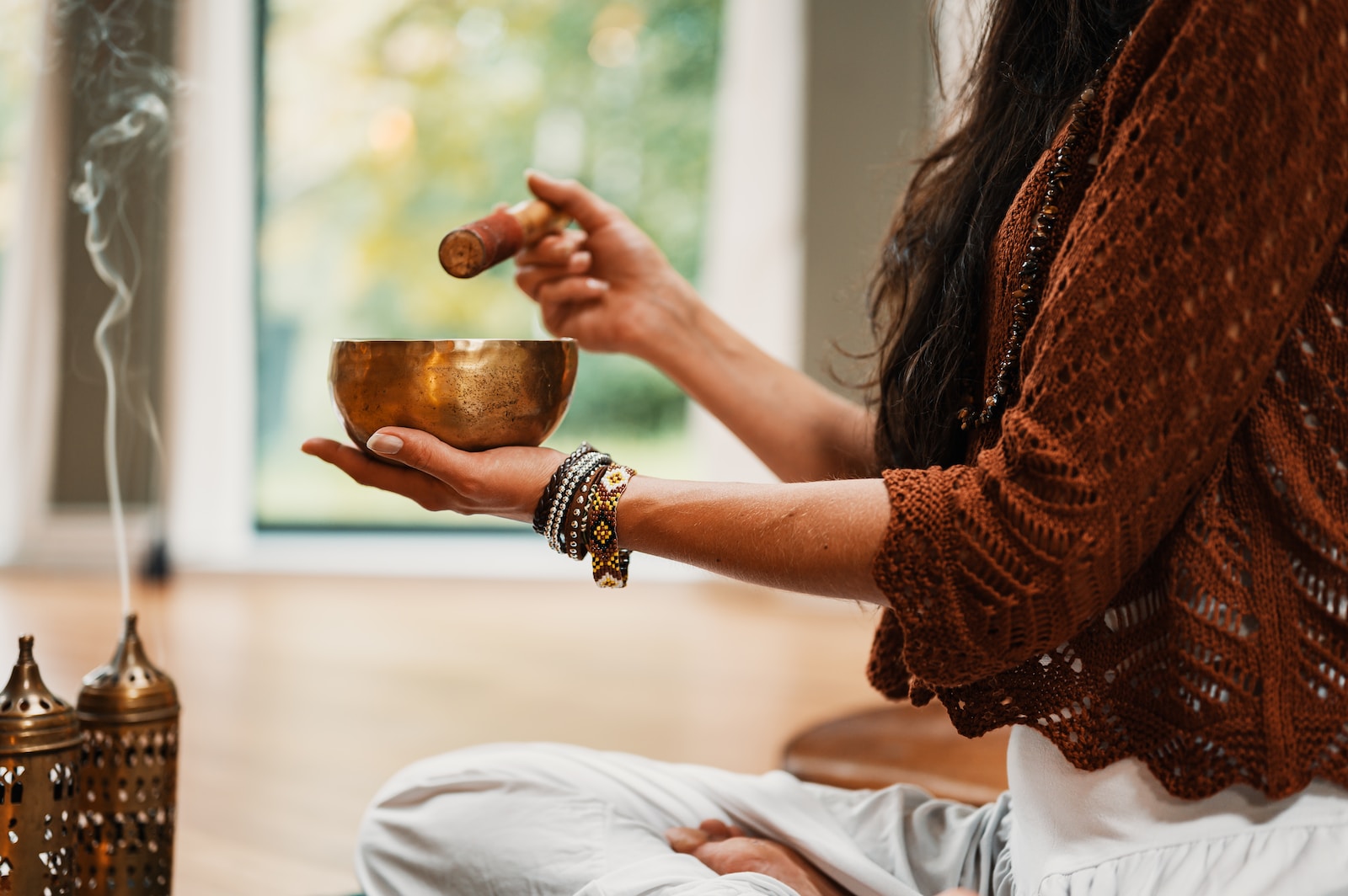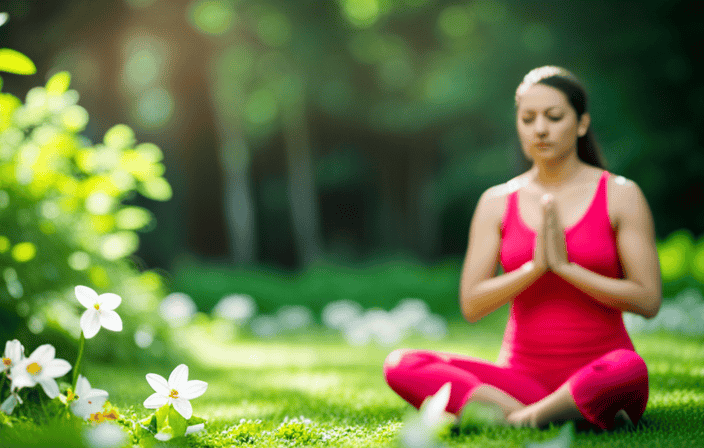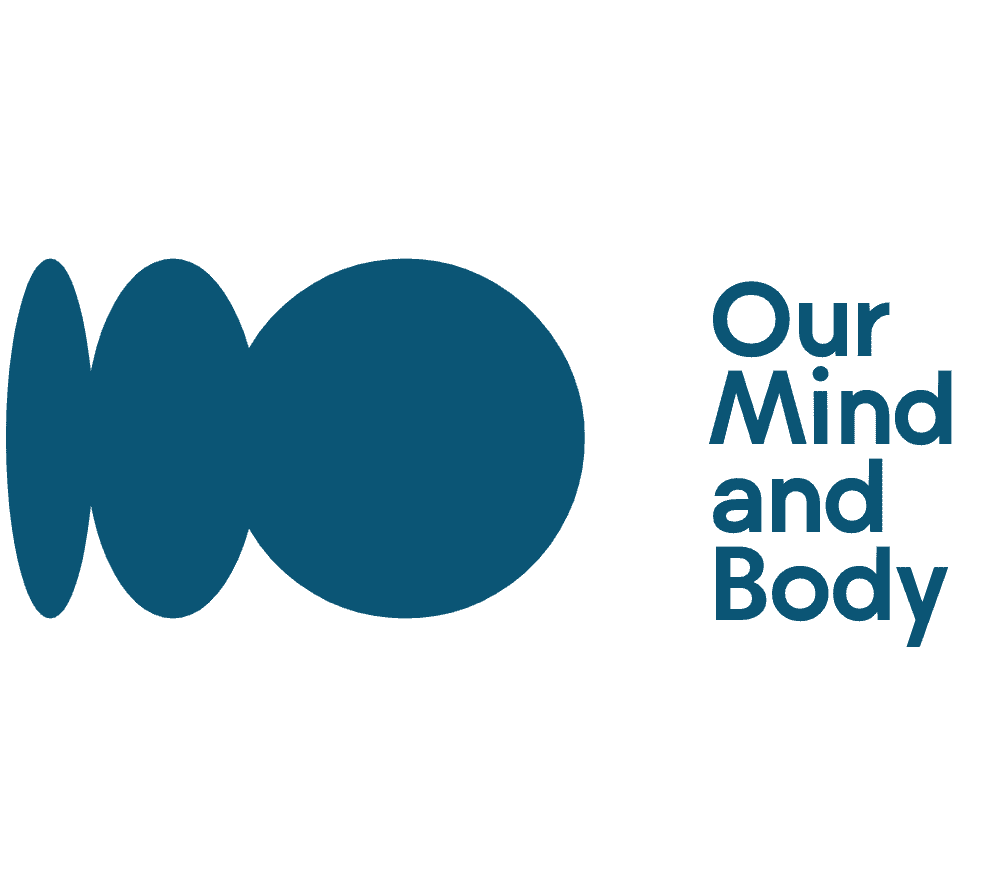Personal Growth
Discover Inner Peace and Resilience Through Mindful Meditation

Mindful meditation is a spiritual practice that helps us focus our attention and awareness on the present moment, while also allowing us to become aware of our thoughts and feelings. It’s an ancient practice for mental wellbeing that has been used by various cultures worldwide for centuries. In today’s society, it is commonly utilized for stress reduction, enhanced concentration, and overall mental equilibrium.
At its core, mindful meditation involves taking time out to observe your own inner experience in a non-judgmental way. This means you can acknowledge whatever emotions or sensations come up without passing any judgement on them – simply allowing yourself to be with what is within. You might focus on your breath, body sensations, sounds around you or another object such as a candle flame; whatever works best for you in that moment.
It takes some practice to learn how to let go and be truly present in any given situation; however once you get into the habit of regularly meditating it can bring about profound changes in how we view life’s challenges. With this newfound clarity comes greater peace of mind and energy to tackle anything that comes our way. So why not steal a few minutes each day to relax and recharge with mindful meditation?
Benefits Of Mindful Meditation
The benefits of mindful meditation are vast and can be especially helpful for managing life’s challenges. Mindful meditation has been scientifically proven to reduce stress, increase relaxation, improve concentration, and boost overall wellbeing. Let’s take a deeper look into the many advantages that come with this simple yet powerful practice:
- Stress Relief Meditation: When we practice mindfulness, it helps us observe our thoughts without judgment or attachment to them. This enables us to step back from our worries and anxieties so they no longer control us. Regular mindful meditation also releases feel-good hormones like serotonin which help create feelings of peace and contentment.
*Mindful Meditation Techniques: By using techniques such as deep breathing exercises, body scans, guided visualizations, mantras, and more – we can learn how to become aware of what’s happening in the present moment while letting go of any expectations or goals associated with the activity. In turn, this allows us to stay focused on one task at a time instead of multi-tasking or feeling overwhelmed by too much going on all at once.
*Deep Relaxation Meditation: When done correctly, mindful meditation can bring about an incredibly calming sensation throughout the entire body – leading to improved sleep quality and increased energy levels during the day! It also helps quiet down racing thoughts allowing you to focus solely on your breath and stillness within your mind. With regular mindfulness practices comes greater self-awareness as well as increased compassion towards others which creates a positive ripple effect in our lives and those around us.
These are just some of the amazing benefits that come along with practicing mindful meditation but there is far more potential available when engaging in this type of exercise regularly! With its vast array of mental health perks available – it’s no wonder why so many people have started incorporating mindfulness into their daily routines for better overall wellbeing. Moving forward let’s dive further into ways you can start introducing mindful practices into your own life today!
Practicing Mindful Meditation
After discussing the incredible benefits of mindful meditation, it’s time to get started. Practicing mindful meditation is easier than one might think and can be done almost anywhere – from your bedroom to a park bench. Whether you want to meditate alone or with others, there are plenty of techniques that can help bring about inner peace and clarity.
To create an effective meditation practice, I suggest starting with this three step process:
| Step | Meditation Technique | Benefits |
|---|---|---|
| 1 | Guided Meditation (listening to guided tracks) | Improves mental focus |
| 2 | Visualization (focusing on calming images in mind) | Boosts creativity |
| 3 | Breathwork (deep breathing exercises) | Reduces stress & anxiety levels |
Guided meditations are audio recordings designed to lead you into a deeper state of relaxation by providing instructions for certain practices such as visualizations and breath work. They’re great if you need assistance focusing or staying centered during your practice. Visualization helps promote creative insights while allowing us to explore our own imaginations, sparking new ideas and perspectives. Finally, breath work encourages deep diaphragmatic breaths which helps calm down our nervous system and reduce tension in the body.
Having identified some basic ways to begin practicing mindful meditation, let’s take a look at how we can make room for these activities within our daily lives.
Making Time For Mindful Meditation
Making the time to practice mindful meditation is one of the best ways to cope with life’s challenges. It can be hard, however, in this busy world we live in, to take a few moments for ourselves and just relax. Here are some tips on how you can make sure that you have enough time for your mindful meditation:
- Allot specific times throughout your day or week dedicated solely to meditating. This could include early morning before work, during lunch break, or even right before bedtime. Having these set times will help you stay accountable and consistent with your practice.
- Incorporate mindful activities into your regular routine like taking deep breaths throughout the day when feeling overwhelmed or stressed out. This allows for short bursts of relaxation which ultimately add up over time.
- Setting reminders for yourself can also help keep you motivated and excited about your practice; whether it’s an alarm clock going off every night at 10 pm reminding you to meditate or having sticky notes around your house prompting you to sit down and breathe deeply each hour – whatever works best for you!
- Finally, create a space within your home where you can go specifically to meditate without any distractions or interruptions from outside sources such as phones ringing or TV noise. A quiet place helps provide the perfect environment for a successful session of mindfulness.
By regularly dedicating certain parts of our days/weeks towards mindful practices such as meditation, we give ourselves permission to recharge our batteries and better handle what life throws our way. With this newfound balance comes improved mental clarity, increased productivity levels and overall more satisfaction with life itself – all things worth striving for!
Finding A Quiet Place To Meditate
John, a busy executive in his late 30s, shared with me that he was feeling overwhelmed by the demands of his job and home life. He needed to find some time for himself, yet it seemed impossible to do. John knew that mindfulness meditation could help him relax and recharge, but where would he find the space?
| Quiet Spot | Peaceful Area |
|---|---|
| Private Space | Serene Environment |
| Silent Room | Tranquil Place |
Finding an appropriate spot for meditation can be challenging. It’s important to find somewhere quiet and undisturbed – a place where you feel safe and comfortable enough to really focus on yourself. A few ideas include your bedroom, a private corner of your living room or office, outdoors under a tree or near water such as a lake or river (if possible). Even if you don’t have access to any of these places, try walking around the block until you come across an area which resonates with your needs. Wherever it is, make sure there are no distractions like people talking nearby or traffic noise from outside. You may need to experiment with different locations before finding one that works best for you.
Mindfulness meditation can offer us relief and clarity during times of stress and overwhelm; however, it will only work if we take the time to create our own personal sanctuary first. Make sure to dedicate regular moments throughout each day just for yourself so you can reap its benefits without interruption from external sources.
Creating A Regular Routine
When it comes to managing life’s challenges, establishing a regular routine that includes mindful meditation can help us relax and recharge. Creating a consistent practice of meditation is key to developing our inner resilience.
Starting with just 10 minutes per day, we can build up our daily practice into something more substantial over time. This could be as simple as setting aside an hour each morning or evening for sitting in stillness or engaging in breathing exercises. We can also create reminders on our phones or write down times when we plan to meditate in order to stay accountable and keep ourselves motivated. Having a mindfulness routine helps provide structure and support during challenging times.
Regularly carving out space for yourself will no doubt bring greater clarity and focus throughout your day-to-day activities. Developing this kind of mindful routine allows us the opportunity to sit with any thoughts or emotions that may arise without judgement and cultivate mental well-being from within. Taking the necessary steps towards creating a consistent practice can empower us to take on life’s challenges head on – leaving us feeling calm and relaxed even amidst chaos!
Starting With Short Sessions
Starting with short sessions of mindful meditation is a great way to build up the habit and get comfortable with the practice. Beginner meditations can be done in as little as five minutes, allowing for easy integration into your daily life. Short duration meditation also allows you to experience the benefits without overwhelming yourself or having to commit more time than necessary.
Mindful mediation techniques can involve focusing on your breath, repeating mantras or affirmations, visualizing positive scenarios, doing gentle yoga stretches, or simply being still with eyes closed while listening to calming music. Simple meditation exercises such as these allow even beginners to quickly learn how to relax their body and mind during a session.
The key when beginning any type of mindfulness practice is consistency; even if it’s just 5-10 minutes per day at first. When starting out, don’t focus too much on perfection – set realistic expectations so that you are able to make steady progress over time. This will help keep you motivated and provide maximum benefit from each session. With consistent practice and dedication, soon enough you’ll find yourself reaping all the wonderful rewards that come with regular mindful meditation!
Common Challenges When Practicing Meditation
It’s no secret that meditation is a powerful tool to reduce stress, improve concentration and find inner peace. However, it isn’t always easy or straightforward to get the desired results from mindful meditation. People often face several common challenges when meditating for the first time.
One of these issues is overcoming distractions. When you sit down to meditate, your mind may wander off into other thoughts and activities which can take away from achieving a state of mindfulness. It’s important to acknowledge these distractions and consciously refocus on your breathing in order to stay present in the moment.
Another challenge people face while trying to meditate is dealing with physical discomfort such as soreness or stiffness in the body or feeling restless due to having too much energy. This can be addressed by adjusting one’s posture accordingly or taking breaks if needed during longer sessions. Additionally, if certain negative emotions come up during meditation, it’s best not to suppress them but rather observe them without judgement before letting them go naturally.
These are just some examples of obstacles people encounter on the path towards successful meditation practice but they don’t have to lead to discouragement or frustration because professional guidance and support can make all the difference when attempting this rewarding activity.
Professional Guidance And Support
When it comes to coping with life’s challenges, professional guidance and support can be invaluable. For example, mindful meditation is a powerful tool that can help us relax, recharge, and gain perspective on our situation. A good meditation practice will include guided meditations as well as regular periods of solitude in which we can become more aware of the present moment and observe our thoughts without judgment.
In addition to its relaxation benefits, mindful meditation has been found to improve concentration and focus during times of stress or anxiety. It also helps build resilience by teaching us how to recognize our own emotions in order to respond constructively instead of reacting impulsively. Finally, research suggests that practicing mindfulness can reduce symptoms associated with depression, such as feelings of hopelessness or worthlessness.
Mindful meditation offers many potential benefits for those struggling with life’s challenges; however, seeking out professional assistance may still be necessary if the difficulties are long-term or difficult to manage alone. With this in mind, let’s explore what impact mindful meditation might have on everyday life…
The Impact Of Mindful Meditation On Everyday Life
Taking time to practice mindful meditation can be a game changer when it comes to coping with life’s challenges. It is like hitting the reset button and helps us to relax, recharge and make positive changes in our daily lives. Here are some of the ways that mindfulness meditation impacts our everyday life:
- Stress relief – Meditation encourages us to take deep breaths which releases tension from the body and reduces stress levels.
- Improved focus – Mindfulness helps increase attention spans by creating mental clarity and allowing us to remain focused on tasks at hand.
- Increased creativity – Practicing meditation opens up creative energy channels that we didn’t even know existed before.
- Enhanced well-being – Regularly meditating allows for an increased sense of self-awareness, peace and overall wellbeing.
Mindful meditation has been proven to help people cope with day-to-day pressures, manage their emotions better, strengthen relationships with others and maintain a healthier lifestyle. By taking just a few minutes out of each day to sit quietly and practice mindful meditation, we can bring about lasting positive changes into our lives both mentally and physically.
Frequently Asked Questions
What Are Some Specific Techniques For Practicing Mindful Meditation?
Mindful meditation is an incredibly powerful tool for calming the mind and body, helping us to relax and recharge in moments of stress or fatigue. In this article, we will discuss some specific techniques for practicing mindful meditation that you can use to center yourself and find peace in difficult times.
The key to successful mindful meditation lies in its simplicity; there are numerous breathing techniques, guided meditations, relaxation exercises, and other methods available online or through apps like Calm or Insight Timer that you can explore as part of your practice. Here are a few ideas to get you started:
- Take a few minutes each day to sit quietly with your eyes closed and focus on your breath until feelings of calm emerge.
- Try listening to recorded mindfulness practices such as mantra chanting, yoga nidra (sleep-based) meditation or progressive muscle relaxation sessions with headphones if needed.
- Incorporate walking meditations into your daily routine—slowly take steps while focusing on being fully present in the moment.
- Join an online community dedicated to using mindfulness-based approaches—this helps create accountability and provides support from others who understand what it’s like when life gets tough!
No matter how busy life may be, taking just five minutes out of our day can help bring clarity, joy and equanimity back into our lives. Mindful meditation is a great way to connect with ourselves at any time – so why not give it a try?
How Do I Know If I’m Doing Mindful Meditation Correctly?
Practicing mindful meditation is a great way to relax and recharge, but how do you know if you’re doing it correctly? When starting out with mindfulness practice, the most important thing is to feel comfortable with your technique. It’s also important to monitor your progress as you become more familiar with mindful meditation. This will help you determine whether or not you are successfully implementing the techniques of mindful meditation.
In order to start correcting your technique, focus on noticing changes in both your body and mind as you meditate. With each breath, think about what sensations come up for you and make sure that your posture is relaxed yet alert. Notice any thoughts that pass through your mind without judgment or attachment. If distracting thoughts arise during meditation, take note of them before gently guiding yourself back to focusing on the present moment.
Tracking progress can be done by noting down the impact of regular mediation sessions in a journal or diary over time. You could note physical benefits such as improved sleep quality or emotional benefits such as increased self-awareness or decreased stress levels – whatever resonates with you! Keeping track of these changes helps you see where improvements have been made so that when doubts arise, they can be quickly dispelled.
Mindful meditation provides many mental health benefits but only if practiced correctly – monitoring progress and making adjustments along the way ensures that this happens. With patience and dedication, anyone can learn to master their own kind of mindfulness practice which works best for them.
Are There Any Risks Associated With Mindful Meditation?
Mindful meditation has been a popular practice for centuries and is now resurfacing in the world of health, wellness, and mental wellbeing. But like any form of personal development or self-care, there are always risks associated with it that should be taken into consideration before embarking on your mindful journey. From potential dangers to physical and psychological effects, understanding these risks can help you protect yourself from harm while reaping all the amazing benefits mindfulness offers.
When done correctly, meditating mindfully can bring about positive changes in both body and mind. However, if not practiced responsibly, you could end up feeling overwhelmed by emotions such as anxiety or depression. In extreme cases where individuals have no prior experience with meditation practices, they may even fall into an altered state of consciousness which could lead to further distress. Therefore it’s important to make sure you’re familiarized with mindful techniques first before starting your own program.
It’s also essential to pay attention to how your body feels during meditation; if you feel physically uncomfortable at any point then take a break and reassess what happened. And remember – although practicing mindfulness can provide many health benefits, it shouldn’t replace traditional medical advice or treatment recommended by healthcare professionals. So when engaging in this activity, keep track of any changes that arise so that you can adjust accordingly and reap its full rewards without putting yourself in danger.
Ultimately mindfulness is an incredibly powerful tool but one needs to tread carefully when incorporating it into their lives – only then will they unlock its true potential safely!
Does The Length Of Time I Meditate Make A Difference?
I’m often asked whether it matters how long I meditate for. The length of time spent meditating can certainly have an effect on the overall outcome, but there’s no one-size-fits-all answer to this question. As a wellness and mental health editor, let me tell you more about what we know so far regarding meditation duration and its impact on our wellbeing.
When we look at research surrounding the optimal duration of meditation practice, findings vary depending on the type of meditation being practiced. For instance, mindfulness-based stress reduction (MBSR) suggests that 45 minutes per day is ideal in order to achieve maximum benefit from your practice; however, if this isn’t achievable then shorter sessions can still be beneficial. Other forms of meditation such as transcendental meditation may recommend longer periods of up to two hours a day in order to experience meaningful changes in one’s well-being over time.
Overall, it appears that the best way forward when deciding on your own personal optimum meditation time is to experiment with different lengths until you find something that works for you. Meditation duration should also depend upon factors like lifestyle commitments and energy levels – many people report finding success by breaking their session into smaller chunks throughout the day rather than trying to focus all their efforts into one extended period each day.
No matter which approach feels best for you, giving yourself permission to carve out some moments for mindful reflection will always yield positive results – whatever your current life challenges might be.
Is It Possible To Meditate With More Than One Person At A Time?
Meditating in a group can be a rewarding experience. Imagine the feeling of being surrounded by multiple people, all focused on one thing – their inner peace and stillness. Being able to meditate with others can add an element of support that is hard to achieve when going it alone. It’s possible to meditate together as a group but there are some things you should keep in mind:
- Set ground rules for talking before beginning the meditation session
- Make sure everyone has enough space to move around comfortably
- Agree on how long each person will have to talk during check-ins
- Discuss potential distractions ahead of time and decide how to deal with them
Though meditating with more than one person may seem daunting at first, it doesn’t need to be too complicated. Taking the time beforehand to ensure everyone understands what’s expected from the group helps create a sense of security which allows individuals to relax and focus on their own practice even if they don’t know everyone else in the room. Furthermore, having different perspectives in conversation afterwards can bring unique insights into your individual journey.
Group meditation provides an opportunity for personal growth while also connecting us with other likeminded individuals who share our same goal of achieving inner peace. With just a few simple considerations, we can make this shared experience both meaningful and enjoyable!
Conclusion
We all face challenges in our lives that can be difficult to cope with. Mindful meditation is a great way to relax and recharge, allowing us to approach these obstacles more effectively. Taking just a few minutes out of your day for mindful meditation can make a world of difference by providing clarity and reducing stress levels.
The key is finding the right techniques to practice mindful meditation correctly. Whether it’s focusing on your breath or repeating mantras, there are various approaches available that can help you focus your attention and achieve deeper states of relaxation. As they say, “practice makes perfect” – so don’t feel discouraged if it takes some time to get the hang of it!
It is important to keep in mind that although mindfulness has many benefits, like any other activity, it also carries its own risks. For instance, too much mindfulness could lead to excessive rumination or avoidance behavior which may not always be helpful. That said, when practiced responsibly and with proper guidance from an experienced professional, mindful meditation can provide powerful tools for managing life’s challenges. So why not give it a try?
Meet Kalinda, the passionate and visionary Editor-in-Chief of OurMindAndBody.com. Kalinda is a beacon of light in the realm of holistic well-being, and her mission is to positively impact the lives of others by inspiring them to embrace a healthier and more fulfilling lifestyle.
With a deep-rooted love for meditation, yoga, and spirituality, Kalinda’s journey toward self-discovery and personal growth started at a young age. She found solace and strength in these practices, which not only helped her cope with the challenges of life but also provided her with a profound sense of purpose. Eager to share the transformative power of these ancient disciplines, Kalinda embarked on a path to spread awareness and understanding.
Personal Growth
The Spiritual Significance Of Shooting Stars: Meaning And Symbolism

Have you ever gazed up at the night sky and witnessed a meteor streaking through the darkness? It’s a moment that mesmerizes us and fills us with wonder and awe.
Shooting stars, both scientifically and spiritually, hold a profound significance. Scientifically, they provide valuable insights into the history and composition of our universe.
But beyond the realm of science, shooting stars carry a deeper, more spiritual meaning. In this article, we will explore the spiritual significance of shooting stars, delving into their symbolism and the profound impact they can have on our lives.
Key Takeaways
- Seeing a shooting star spiritually is believed to bring good luck and positive energy
- Many cultures associate shooting stars with messages from the spiritual realm or the universe
- Shooting stars are often interpreted as a sign of new beginnings or endings
- Symbolic meanings of shooting stars include new ideas, wishes, dreams, and spiritual journeys
What are shooting stars?
I’ve learned that shooting stars are natural phenomena caused by debris from space entering the Earth’s atmosphere, and they burn up, creating a bright streak of light across the sky.
It’s fascinating to think about the mythological origins and cultural beliefs surrounding shooting stars. In many cultures, they are seen as messages from the spiritual realm or the universe. Some believe that seeing a shooting star spiritually brings good luck and positive energy, while others associate them with new beginnings or endings.
The symbolic meanings attached to shooting stars can vary widely, depending on individual perspectives and cultural beliefs. For some, they represent wishes, dreams, and spiritual journeys. Others may see them as signs of transformation, growth, or even bad luck.
Regardless of the interpretation, witnessing a shooting star always leaves a lasting impression, igniting a sense of wonder and awe in those fortunate enough to see one.
Scientific explanation
Astronomers study shooting stars using telescopes and instruments to provide a scientific explanation for the phenomenon. Through the exploration of shooting stars, scientific research on shooting stars has revealed fascinating insights into the celestial world. Here are four key findings:
-
Understanding celestial body movement and composition: By studying shooting stars, scientists gain valuable knowledge about how celestial bodies move and their composition. This research helps piece together the history of our Solar System.
-
Insights into the formation of celestial bodies: Analyzing the fallen meteors from shooting stars allows scientists to determine the age and make-up of the Solar System. This information provides valuable insights into the formation of celestial bodies.
-
Unveiling the evolution of the Solar System: Meteor composition analysis sheds light on the evolution of the Solar System. By studying shooting stars, scientists can understand the presence of certain elements in space and gain a deeper understanding of the Solar System’s evolution.
-
Enhancing appreciation for the phenomenon: Understanding the scientific explanation behind shooting stars enhances our appreciation for this awe-inspiring phenomenon. It allows us to marvel at the beauty of shooting stars while also acknowledging the immense knowledge that scientific research has provided.
Regular occurrence
During meteor showers, I love to search for shooting stars in the night sky. It’s a magical experience that fills me with wonder and awe. To make the most out of these celestial events, it’s important to know the meteor shower dates and the best locations for stargazing. Meteor showers happen regularly throughout the year, with the Perseids meteor shower being one of the most well-known, occurring in August. But there are many other meteor showers that take place annually, each with different levels of activity. To increase your chances of seeing shooting stars, find a location away from city lights for better visibility and choose a spot with an unobstructed view of the sky. By being patient and allowing your eyes to adjust to the darkness, you can fully immerse yourself in the beauty of these shooting stars.
Importance of meteor composition analysis
Analyzing the composition of fallen meteors is crucial for understanding the age and make-up of the Solar System. Meteor shower analysis provides valuable insights into the formation of celestial bodies and the evolution of our Solar System.
By studying the chemical composition of these fallen meteors, scientists can unravel the mysteries of our planetary system. It reveals information about the presence of certain elements in space and helps piece together the story of celestial body formation.
This analysis not only enhances our understanding of the Solar System but also deepens our appreciation for the beauty and complexity of the universe. It is through the study of meteor composition that we gain a glimpse into the vastness and wonder of the cosmos, igniting a sense of inspiration and awe within us.
Tips for observing
To enhance your experience of observing shooting stars during meteor showers, it is helpful to find a location away from city lights for better visibility. The best locations for stargazing are usually in remote areas where light pollution is minimal. Choose a spot with an unobstructed view of the sky to maximize your chances of seeing shooting stars.
It’s also important to be patient and allow your eyes to adjust to the darkness. Additionally, if you’re interested in capturing the beauty of shooting stars through photography, there are a few tips to keep in mind. Use a tripod to keep your camera steady, set a wide aperture to let in more light, and use a long exposure to capture the movement of the shooting stars.
With these tips, you can fully immerse yourself in the awe-inspiring experience of witnessing shooting stars during meteor showers.
Positive spiritual beliefs
Experiencing a shooting star fills me with a sense of positivity and brings a feeling of good luck and possibility. It’s as if the universe is sending a message of encouragement and reminding me of the infinite potential within myself.
When I see a shooting star, I take a moment to reflect and express gratitude for the blessings in my life. I then set positive intentions for the future and visualize my dreams and desires manifesting into reality. This act of manifestation is a powerful spiritual practice that helps me stay focused on my goals and allows me to attract the positive energy needed to achieve them.
It’s a reminder that I have the power to create my own destiny and that the universe is conspiring in my favor. So, the next time you witness a shooting star, take a moment to embrace its positive energy and utilize it as a catalyst for your own personal growth and transformation.
Negative spiritual beliefs
When I witness a shooting star, it fills me with a sense of unease and foreboding, as if it is a sign of impending doom or misfortune. In many cultures, shooting stars are associated with negative meanings and superstitions. Some believe that seeing a shooting star is a symbol of death or a bad omen. These beliefs stem from ancient superstitions and cultural interpretations passed down through generations. The idea of a shooting star representing the end of something or a warning of impending tragedy can be deeply ingrained in our subconscious. This negative symbolism attached to shooting stars serves as a reminder to cherish the present moment and appreciate the blessings in our lives. It encourages us to reflect on our actions and make positive changes to avoid any potential negative outcomes.
| Negative Symbolism | Superstitions about Shooting Stars |
|---|---|
| Death | A sign of impending tragedy |
| Misfortune | Bad luck associated with shooting stars |
| Omen | A warning of negative events |
| Impending doom | A sense of foreboding and unease |
Reflection and gratitude
After witnessing a shooting star spiritually, it is natural to be filled with a sense of wonder and awe. The beauty and fleeting nature of these celestial phenomena leave a lasting impression on our hearts and minds.
As I reflect on the spiritual significance of shooting stars, I am reminded of the importance of gratitude in our lives. Taking a moment to pause and appreciate the magic that unfolds before us can be a powerful spiritual practice. It allows us to connect with the universe and acknowledge the infinite possibilities that exist.
Expressing gratitude for the opportunity to witness such a breathtaking sight opens our hearts and minds to the abundance of blessings that surround us. In these moments of reflection and gratitude, we align ourselves with the positive energy of the universe, inviting more miracles and blessings into our lives.
Cultural interpretations
Cultural interpretations of shooting stars vary widely, with different belief systems attributing various messages and events to their appearance. Throughout history, these celestial phenomena have held immense cultural significance, captivating the imaginations of people from all walks of life.
Here are a few examples of how different cultures have interpreted the spiritual meaning of shooting stars:
-
In ancient Greek mythology, shooting stars were seen as a sign of divine favor or displeasure. They were believed to be the souls of deceased loved ones, guiding and protecting those who witnessed them.
-
Native American tribes viewed shooting stars as communication from the spirit world. They believed that these celestial visitors brought messages from ancestors or spirit guides, offering guidance and wisdom.
-
In Chinese culture, shooting stars are associated with luck and prosperity. It is believed that making a wish upon a shooting star can bring good fortune and help manifest one’s desires.
-
In Hinduism, shooting stars are seen as a symbol of transformation and the cycle of life. They represent the journey of the soul and the potential for spiritual growth and enlightenment.
These cultural interpretations highlight the deep-rooted historical significance of shooting stars and the diverse ways in which they have been understood and revered. They remind us of the interconnectedness of humanity and the universal human desire to find meaning in the natural world.
Symbolic representations
As I delve deeper into the spiritual significance of shooting stars, I can’t help but marvel at the myriad of symbolic representations attached to these celestial wonders.
Beyond cultural interpretations, shooting stars hold a profound connection to astrology and spiritual rituals. They are seen as celestial messengers, carrying messages from the universe to guide us on our spiritual paths.
Many spiritual rituals involve making wishes or setting intentions when a shooting star streaks across the night sky, believing that these desires will manifest into reality. The fleeting nature of shooting stars reminds us to cherish the present moment and seize opportunities for growth and transformation.
They ignite a sense of wonder and awe, inspiring us to pursue our dreams and aspirations. In this vast universe, shooting stars serve as spiritual beacons, reminding us of the infinite possibilities that await us on our journey.
Inspiration and motivation
Experiencing a shooting star ignites a deep sense of inspiration and motivation within me. It reminds me of the infinite possibilities that exist in the universe and the power of our dreams and aspirations. When I gaze upon a shooting star, I am reminded of the importance of finding purpose and pursuing our true passions in life. It serves as a gentle nudge from the universe, encouraging me to take action and follow my heart’s desires. The shooting star represents the fleeting nature of life and the importance of seizing every moment. It reminds me to never give up on my dreams, no matter how big or small they may be. Witnessing a shooting star fills me with a sense of wonder and awe, and it reinforces my belief in the beauty and magic of the world around us.
| Finding Purpose | Pursuing Dreams |
|---|---|
| – Shooting stars remind us of the importance of finding our purpose in life. | – They inspire us to pursue our dreams and aspirations. |
| – They serve as gentle reminders to follow our hearts and do what truly makes us happy. | – Shooting stars symbolize the infinite possibilities that exist in the universe. |
| – The fleeting nature of shooting stars reminds us to seize every moment and make the most of our lives. | – They encourage us to take action and not be afraid to chase after our dreams. |
| – Witnessing a shooting star sparks a sense of motivation and reminds us of the beauty and magic of the world. | – They reinforce our belief that anything is possible if we have the courage to pursue it. |
Magical and enchanting experience
The sight of a shooting star creates a mesmerizing and enchanting moment that captivates my senses. As I gaze at the night sky, a shooting star streaks across the darkness, leaving behind a trail of shimmering light.
In that fleeting instant, I feel a deep sense of connection with the universe, as if the vast expanse of space is reaching out to touch my soul. It is a reminder of the infinite possibilities that exist in the universe and within myself.
The magical nature of shooting stars ignites a spark within me, awakening my spirit and inspiring me to embrace my own journey of self-discovery. In that brief encounter with the shooting star, I am reminded to stay true to my path, to follow my dreams, and to trust in the power of the universe to guide me towards my highest purpose.
Frequently Asked Questions
Are shooting stars actually stars?
No, shooting stars are not actually stars. They are debris from space, such as meteoroids, that enter the Earth’s atmosphere and burn up, creating a bright streak of light across the sky.
Can shooting stars grant wishes?
Shooting stars have captivated human imagination for centuries, with magical folklore suggesting they can grant wishes. While scientific explanations reveal their true nature, the idea of wishes coming true adds a sense of wonder and hope to the experience.
What do shooting stars symbolize in different cultures?
Cultural interpretations of shooting stars vary widely, reflecting the diverse beliefs and historical significance of different cultures. They can symbolize new beginnings, messages from the spiritual realm, hope, and inspiration, among other concepts.
Are there any negative beliefs associated with shooting stars?
Witnessing a shooting star can be a breathtaking experience, but there are some negative beliefs associated with them. Some cultures view shooting stars as omens of death or bad luck, which can have a disheartening effect on those who witness them.
How can witnessing a shooting star impact someone’s spiritual journey?
Witnessing a shooting star can have a profound impact on my spiritual journey. It reminds me of the vastness of the universe and my connection to it. It inspires personal growth, ignites a sense of wonder, and encourages me to pursue my dreams.
Conclusion
As I gaze up at the night sky, witnessing the fleeting beauty of a shooting star, I am reminded of the profound spiritual significance that these celestial wonders hold. They are more than just natural phenomena; they are messengers from the universe, igniting a sense of wonder and hope within our souls.
Like the shooting star that streaks across the darkness, we too have the power to leave a lasting impression and inspire others with our dreams and aspirations. Just as the shooting star lights up the night sky, let us illuminate our own paths and embrace the magic and enchantment of life’s journey.
Say hello to Cypress, the soulful wordsmith behind the insightful articles at OurMindAndBody.com. Cypress is a gifted writer who weaves words with grace and precision, using language as a powerful tool to inspire, heal, and uplift the spirits of readers.
With a background in literature and a passion for personal growth, Cypress brings a unique perspective to the world of well-being and spirituality. Having experienced the transformative effects of meditation and yoga firsthand, Cypress is deeply connected to the essence of these practices and their potential to enrich lives.
Personal Growth
The Spiritual Significance Of The Name James

Did you know that the name James has deep spiritual significance? Coming from Hebrew, meaning ‘supplanter’ or ‘holder of the heel,’ the name James represents persistence, courage, and the skill to overcome obstacles.
Numerologically, it carries a value of 11, symbolizing leadership and spiritual enlightenment. Astrologically aligned with Mars, it embodies courage and assertiveness. The symbolic significance of its letters further reveals optimism, sensitivity, and intuition.
Additionally, James is associated with reliability, loyalty, and leadership, offering protection and guidance in various cultures.
Join me as we explore the profound spiritual meaning of the name James.
Key Takeaways
- The name James has a spiritual meaning of persistence, courage, and overcoming obstacles.
- Numerologically, the name James has a value of 11, indicating leadership qualities and spiritual enlightenment.
- Astrologically, the name James corresponds with the planet Mars, symbolizing courage and assertiveness.
- The letters in the name James, such as J and S, hold symbolic significance, representing optimism, excitement, sensitivity, and intuition.
Origin and Meaning
The origin and meaning of the name James is quite fascinating. It is derived from the Hebrew name Yaakov, which means supplanter or holder of the heel.
In a spiritual context, the name James represents someone who is persistent, courageous, and willing to overcome obstacles.
This name holds great significance in numerology and astrology as well. Numerologically, James has a numerical value of 11, indicating leadership qualities and spiritual enlightenment. Astrologically, the name corresponds with the planet Mars, signifying courage and assertiveness.
The symbolic significance of the letters in James adds depth to its meaning. The J represents optimism and excitement for life, while the S signifies sensitivity and intuition.
Overall, the name James carries a powerful spiritual meaning. It reflects qualities of strength, determination, and the ability to rise above challenges.
Numerological Symbolism
Numerology unveils the captivating power behind the numeric value of my name, as the number 11 ignites a blazing trail of leadership and spiritual enlightenment. This numerical value signifies my innate ability to lead and inspire others, as well as my deep connection to the spiritual realm.
I am driven by a strong sense of purpose and a desire to make a positive impact on the world. The number 11 also represents spiritual enlightenment, indicating that I am constantly seeking higher truths and wisdom.
It is through my leadership qualities and dedication to spiritual growth that I am able to navigate the challenges and obstacles that come my way. Numerology allows me to understand and embrace the profound significance of my name, James, as it illuminates the path of my life journey.
Astrological Associations
Astrologically speaking, Mars represents my courage and assertiveness, providing me with the strength to face challenges head-on. In numerology, the name James corresponds with the numerical value of 11, indicating my leadership qualities and spiritual enlightenment.
This celestial connection allows me to tap into my innate sense of determination and fearlessness. As a result, I am able to navigate through life’s obstacles with unwavering resolve.
The position of each letter in my name holds symbolic significance as well. The J signifies my optimism and excitement for life, while the S represents my sensitivity and intuition. These qualities, combined with the influence of Mars, shape my life journey and contribute to my character.
The name James, with its spiritual meaning of persistence and courage, serves as a constant reminder of my ability to overcome any challenge that comes my way.
Symbolic Significance of Letters
In understanding the symbolic significance of letters in my name, I find that the J represents my optimism and excitement for life, while the S signifies my sensitivity and intuition.
The letter J is associated with the planet Jupiter, which symbolizes expansion and growth. This resonates with my personality as I always strive for personal and spiritual development.
The S, on the other hand, correlates with the moon, representing emotions and intuition. I am highly empathetic and intuitive, often relying on my instincts to guide me in making decisions.
Understanding these symbolic meanings of the letters in my name gives me a deeper insight into my life journey and the qualities that define me. It allows me to embrace and cultivate these qualities, leading to a more fulfilling and purposeful existence.
Biblical References
When exploring the biblical references associated with my name, I feel a deep connection to the stories of James the son of Zebedee and James the son of Alphaeus, as they exemplify the strength and resilience required to navigate life’s challenges.
James the son of Zebedee was one of the twelve apostles chosen by Jesus, and he played a significant role in spreading the teachings of Christianity. He was known for his unwavering faith and commitment, even in the face of persecution and adversity.
James the son of Alphaeus, also known as James the Less, was another disciple of Jesus and was known for his humility and dedication to serving others.
Both Jameses serve as powerful examples of how faith and determination can guide us through difficult times and inspire us to lead lives of purpose and devotion.
Famous Namesakes
One of the most well-known individuals who shares my name is the actor James Franco. He is a versatile and talented actor who has appeared in numerous films and television shows.
-
First, imagine being on the set of a blockbuster film with James Franco. The cameras are rolling, and he effortlessly embodies his character, captivating the audience with his powerful presence and emotional range.
-
Next, picture attending a prestigious awards ceremony alongside James Franco. He gracefully walks the red carpet, exuding confidence and style. As he accepts his well-deserved award, his charismatic smile lights up the room.
-
Finally, envision sitting in a theater, watching a play directed by James Franco. His creative vision and attention to detail shine through, transporting the audience into a world of art and imagination.
These scenarios illustrate the impact and influence that someone with the name James can have in the entertainment industry, showcasing their talent, dedication, and ability to captivate audiences.
Cultural Beliefs and Traditions
Growing up in a close-knit Italian-American community, I vividly remember the annual Feast of Saint James celebration, where families would come together to honor their patron saint with a lively parade, delicious food, and traditional music and dancing. This cultural belief and tradition held a significant spiritual meaning for us, as Saint James was believed to offer protection and guidance. The celebration allowed us to connect with our faith and heritage, and it served as a reminder of the values associated with the name James, such as reliability, loyalty, and leadership.
To paint a picture of the Feast of Saint James, here is a table showcasing some of the elements that made this celebration so special:
| Feast of Saint James Celebration | |
|---|---|
| Lively Parade | Delicious Food |
| Traditional Music | Dancing |
| Community Gathering | Honoring Patron Saint |
This annual event not only brought our community together but also reinforced the spiritual significance of the name James in our lives.
Nicknames and Variations
I’ve always loved the various nicknames and variations of my name, James. It is fascinating to see how this name can be transformed and adapted in different cultures and contexts.
In English-speaking countries, common nicknames for James include Jim, Jimmy, and Jamie. These variations add a sense of familiarity and informality to the name, making it more approachable.
In other cultures, there are different variations of the name James that carry their own unique meanings and connotations. For example, in Spanish, the name Santiago is a common variation of James, which means ‘Saint James.’ This variation emphasizes the spiritual and religious significance of the name.
Overall, the nicknames and variations of the name James showcase the versatility and adaptability of this timeless name.
Frequently Asked Questions
Is there a specific spiritual ritual or ceremony associated with the name James?
There is no specific spiritual ritual or ceremony associated with the name James. The spiritual significance of the name lies in its meaning and symbolism, representing qualities such as persistence, courage, and overcoming obstacles.
Are there any specific gemstones or crystals that are believed to enhance the spiritual energy of the name James?
Oh, the wonders of gemstones and crystals! When it comes to enhancing the spiritual energy of the name James, I’m afraid there isn’t a specific gem associated with it. But fear not, for the power lies within the name itself.
Does the spiritual significance of the name James change depending on the person’s astrological sign?
The spiritual significance of the name James does not change depending on a person’s astrological sign. The name James represents persistence, courage, and overcoming obstacles in a spiritual context, regardless of astrological influences.
Are there any specific prayers or mantras that are often associated with the name James?
There are no specific prayers or mantras exclusively associated with the name James. However, individuals named James can choose to use any prayer or mantra that resonates with their personal beliefs and spiritual practices.
Are there any specific spiritual practices or traditions that individuals with the name James are encouraged to follow?
As an individual with the name James, there are no specific spiritual practices or traditions that I am encouraged to follow. However, the name James symbolizes persistence, courage, and a willingness to overcome obstacles, which can guide my spiritual journey.
Conclusion
In conclusion, the name James holds immense spiritual significance.
Its Hebrew origin, Yaakov, signifies perseverance and the ability to overcome obstacles.
Numerologically, the value of 11 represents leadership and spiritual enlightenment.
Astrologically, Mars symbolizes courage and assertiveness, attributes associated with the name James.
The letters in the name also contribute to its symbolic significance, with J representing optimism and S signifying sensitivity and intuition.
The biblical references and cultural beliefs further enhance the name’s spiritual meaning.
Overall, the name James is a powerful symbol of perseverance, courage, and triumph in the face of challenges, making it truly remarkable.
Say hello to Cypress, the soulful wordsmith behind the insightful articles at OurMindAndBody.com. Cypress is a gifted writer who weaves words with grace and precision, using language as a powerful tool to inspire, heal, and uplift the spirits of readers.
With a background in literature and a passion for personal growth, Cypress brings a unique perspective to the world of well-being and spirituality. Having experienced the transformative effects of meditation and yoga firsthand, Cypress is deeply connected to the essence of these practices and their potential to enrich lives.
Personal Growth
The Spiritual Significance Of Black Candle Jars: Unlocking Symbolism And Personal Transformation

Step into the mystical world of black candle jars, where the soft illumination not only brightens a room but also touches the depths of your soul. These jars serve as a mystical tool, unlocking pathways to change, cleansing, and safeguarding.
They are more than mere objects; they are gateways to personal growth and spiritual connection. As we delve into the symbolism behind black candle jars, we embark on a journey of self-discovery, where shadows are embraced, negativity is released, and transformation becomes our guiding light.
Key Takeaways
- Black candle jars are associated with purification, protection, and banishing negative energy in one’s personal spiritual journey.
- The causes of black candle jars can vary, including the quality of wax, low-quality wick, improper burning techniques, and the impact of candle colors.
- Understanding the spiritual meaning and reasons for candle blackening is important for interpreting the symbolism behind black candle jars.
- Candle colors have specific meanings and associations, and selecting the appropriate color can enhance the desired outcome in spiritual practices.
What is it?
I know that black candle jars have a spiritual significance and can unlock symbolism and promote personal transformation.
Understanding symbolism is like peering into the depths of our souls, searching for hidden truths and untapped potential.
Just as the black candle jar holds the flickering flame, it also holds the power to ignite our inner fire. It symbolizes spiritual purification, a cleansing of the soul, and a release of negative energy.
When we embrace the black candle jar in our rituals, we invite protection and banish the darkness that may cloud our minds.
It is through this act of lighting the black candle jar that we embark on a journey of self-discovery and transformation. As the flame dances and casts its mesmerizing glow, we are reminded of the power within us to illuminate our path and create our own destiny.
Causes and Prevention
Understanding the causes of blackening in candle jars and implementing proper burning techniques can help prevent this issue. Prevention is key when it comes to maintaining the quality of our candles and maximizing their spiritual significance.
Just as in life, we must be mindful of our actions and choices to avoid negative outcomes. By taking the time to select high-quality wax and wicks, we can ensure a clean and pure burning experience. It is essential to pay attention to the fragrance oils we use, as excessive usage can contribute to blackening.
Furthermore, mastering proper burning techniques, such as trimming the wick and allowing the candle to burn evenly, will enhance the longevity of our candles and prevent blackening.
Let us strive to improve the quality of our candles, allowing their vibrant light to illuminate our spiritual journey.
Interpreting Meaning
Exploring the different interpretations of the meaning behind blackened candle jars enhances my understanding of their role in my spiritual journey. As I delve deeper into the symbolism associated with these jars, I uncover new layers of meaning and insight. Each blackened jar represents a transformation, a purification of the soul, and a shield against negativity. It serves as a visual reminder of the power I hold to banish darkness and embrace the light within.
To aid in my exploration, I have created a table that captures the essence of the spiritual growth that can be achieved through the interpretation of black candle jars:
| Symbolism | Spiritual Growth | Interpretation |
|---|---|---|
| Transformation | Embracing change | Letting go of old patterns and beliefs to make space for personal growth and evolution. |
| Purification | Releasing negativity | Cleansing the spirit of negative energy and fostering a sense of inner peace. |
| Protection | Shielding from harm | Creating a spiritual barrier to safeguard against external influences and negative forces. |
By understanding the diverse interpretations of black candle jars, I am able to harness their power and incorporate them into my daily rituals for spiritual growth. They serve as a constant reminder of the transformative journey I am on and the importance of embracing the symbolism they hold.
Candle Colors and Meanings
Selecting the appropriate color of a candle allows for a deeper connection to desired outcomes and enhances the effectiveness of spiritual practices. Candle colors hold significant meanings and can be used to amplify intentions in our daily rituals.
Combining candle colors is like blending different hues on a canvas, creating a masterpiece of energy and intention. Just as an artist combines shades to evoke specific emotions, we can combine candle colors to enhance our intended outcomes.
For example, combining a black candle, symbolizing protection and banishing negativity, with a white candle, symbolizing purity and clarity, can create a powerful synergy in our spiritual journey.
It is through this intentional blending of colors that we find ourselves truly immersed in the transformative power of black candle jars, unlocking their symbolism and experiencing personal transformation.
Impact on Spiritual Journey
Experiencing the impact of black candle jars on my spiritual journey has been profound and transformative.
Exploring the symbolism behind these jars, I have discovered a powerful tool for harnessing transformation in my life. Like the darkness that precedes the dawn, the black candle jars represent the necessary journey into our own shadows and depths.
As the candle burns, it purifies, banishing negative energy and paving the way for personal growth. Just as the black candle jars release their black residue, I too release the negativity and limitations that no longer serve me.
Through this process, I am able to ground myself, finding stability and strength amidst the chaos of life. The black candle jars symbolize the journey of transformation, reminding me that from darkness comes light, and from ashes rises the phoenix.
During my spiritual journey, I have found that incorporating black candle jars has had a profound impact on my growth and transformation. Exploring the symbolism behind these jars has allowed me to delve deeper into my inner world, unlocking hidden aspects of myself and embracing transformation.
The black candle jars serve as powerful tools, symbolizing the journey of purification and protection. They act as a mirror, reflecting the shadows within, urging me to release negativity and embrace the light. As I light the candle and watch the black residue slowly melt away, I am reminded of the power of transformation and the constant shedding of the old to make way for the new.
Embracing the spiritual significance of black candle jars has allowed me to align my beliefs and values, grounding me in my journey towards self-discovery and personal growth. With each candle ritual, I am reminded of the power of intention and the importance of focus.
These black candle jars have become a constant companion, enhancing my spiritual connection and deepening my understanding of myself and the world around me.
Incorporating black candle jars into my daily rituals has deepened my spiritual connection and heightened my understanding of myself and the world around me.
Exploring the symbolism behind these jars has allowed me to embrace personal transformation in a profound way. The black residue left behind after burning a candle represents the release of negativity and the purification of my spirit. It is a reminder that through shadow work and grounding, I am able to banish negative energy and protect myself from its influence.
Each time I light my black candle jar, I am reminded of the transformative power within me and the importance of releasing what no longer serves me. It is a symbol of strength and resilience, guiding me on my spiritual journey towards growth and enlightenment.
By embracing the spiritual significance of black candle jars, I have unlocked a deeper understanding of myself and the world, allowing me to walk the path of personal transformation with intention and purpose.
Using black candle jars in my daily rituals has greatly deepened my connection to the spiritual realm and enhanced my personal growth journey. Exploring the symbolism behind these jars has allowed me to tap into a deeper understanding of myself and the world around me.
Each time I light a black candle, I am reminded of the power of intention and the importance of focus in my spiritual practices. The black residue left behind after burning represents the transformation and purification that takes place within me. It is a visual reminder of the negative energy and emotions that I release, allowing space for positivity and light to enter.
Through my connection with these rituals, I have found a sense of grounding and protection, enabling me to navigate life’s challenges with grace and resilience.
Frequently Asked Questions
Are there any specific rituals or practices associated with using black candle jars in spiritual journeys?
Exploring the symbolism of black candle jars in different spiritual practices, I’ve discovered rituals that enhance personal transformation. Through my own experiences, I’ve witnessed the power of intention and the profound impact of using black candle jars on my spiritual journey.
Can black candle jars be used for manifesting positive outcomes, or are they primarily used for banishing negativity?
Black candle jars have a transformative power beyond banishing negativity. By harnessing the power of intention, they can manifest positivity and guide us on a journey of personal growth and spiritual enlightenment.
How can one determine the quality of wax and wick when purchasing black candle jars?
When purchasing black candle jars, I focus on determining the quality of wax by looking for a smooth texture and clean burn. I also check the wick quality by ensuring it is sturdy and centered for an optimal candle-burning experience.
Are there any specific candle burning techniques or care instructions that can help prevent blackening of the jar?
To prevent blackening of the jar, I’ve discovered some candle cleaning techniques that are truly magical. By regularly trimming the wick, avoiding drafts, and cleaning with vinegar, I keep my candles shining bright, preventing soot buildup.
Can the spiritual meaning of black candle jars vary across different cultures or belief systems?
Cultural variations and belief system influences can shape the spiritual meaning of black candle jars. Like diverse colors blending on a canvas, our interpretations intertwine, creating a tapestry of symbolism that reflects our unique spiritual journeys.
Conclusion
As I reflect on the profound journey of the black candle jar, I am reminded of the power it holds to transform our beings.
Like a guiding light in the darkness, this sacred vessel purifies our souls, banishing negativity and protecting our spirits.
Its symbolism is a gateway to personal growth, a path towards understanding and connection.
With each flicker of its flame, we embark on a spiritual quest, embracing the colors that represent our intentions.
Let us unlock the secrets of the black candle jar and ignite the fire of transformation within ourselves.
Say hello to Cypress, the soulful wordsmith behind the insightful articles at OurMindAndBody.com. Cypress is a gifted writer who weaves words with grace and precision, using language as a powerful tool to inspire, heal, and uplift the spirits of readers.
With a background in literature and a passion for personal growth, Cypress brings a unique perspective to the world of well-being and spirituality. Having experienced the transformative effects of meditation and yoga firsthand, Cypress is deeply connected to the essence of these practices and their potential to enrich lives.
-

 Personal Growth2 months ago
Personal Growth2 months agoThe Power Of Kindness: Cultivating Happiness, Connection, And Personal Growth
-

 Meditation1 day ago
Meditation1 day agoUnderstanding Spiritual Attacks: Types, Signs, And Protection
-

 Aura1 week ago
Aura1 week agoUnderstanding The Grey Aura: Balance, Neutrality, And Personal Growth
-

 Spirituality3 months ago
Spirituality3 months agoThe Power Of Spiritual Connection: Definition, Importance, And Ways To Achieve
-

 Spirituality2 months ago
Spirituality2 months agoStarting Your Spiritual Journey: Self-Reflection, Growth, And Connection
-

 Spirituality3 months ago
Spirituality3 months agoConnecting Spirituality And Daily Life: Embracing Universal Values
-

 Spirituality3 months ago
Spirituality3 months agoThe Mystical Realms: Exploring Spiritual Dimensions
-

 Meditation3 weeks ago
Meditation3 weeks agoThe Symbolic Significance Of Sand Dollar: Spiritual Meanings And Cultural Connections

















